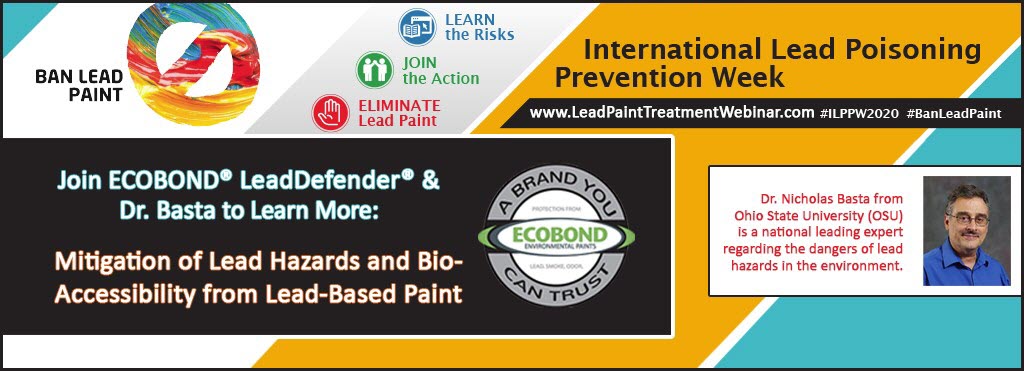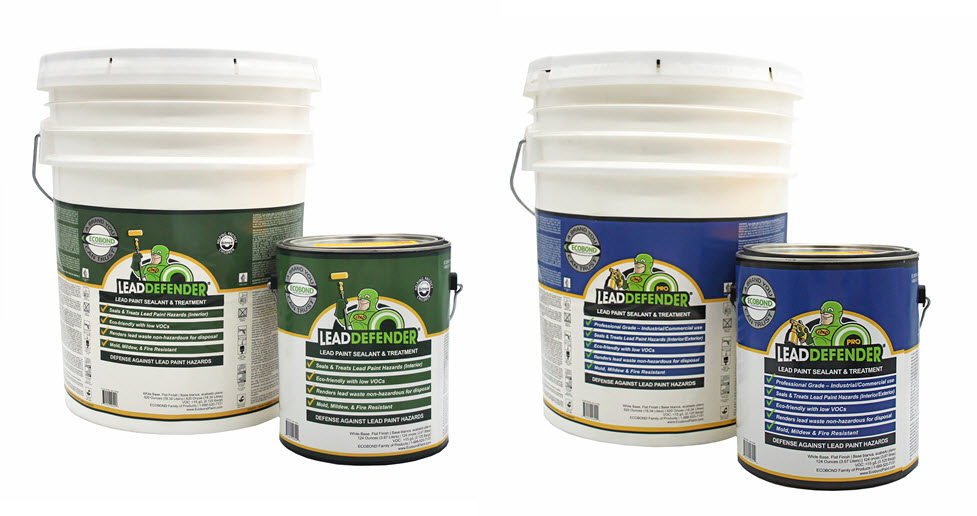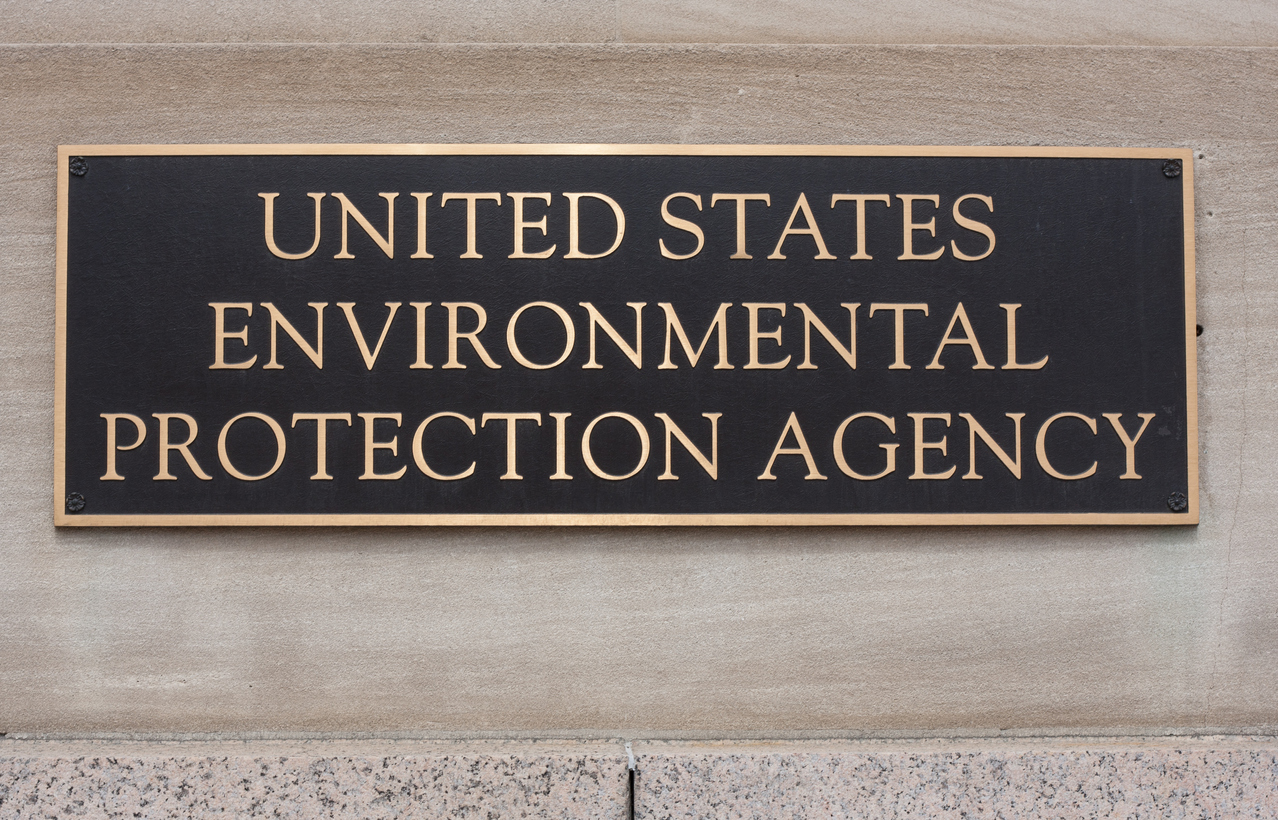
ECOBOND® Paint: Welcome to this conversation about bioaccessibility and extractability of ECOBOND® LeadDefender® treated lead-based paint. We are joined by Dr. Nicholas Basta, professor of soil and environmental health environmental chemistry at Ohio State University, and Mr. Paul Barthel, a representative with ECOBOND® environmental paints.
Dr. Nicholas Basta: I'm glad to discuss a study that we did to evaluate ECOBOND® LeadDefender®'s effectiveness on lead paint biodegradability. My expertise is research about assessment and treatment remediation of lead and other heavy metal contaminated media. Myself and my research associate Shane Whitaker were involved with this project.
We have a lead problem. We have a public health crisis in Cleveland, and for example, we have long historical excessive blood lead levels in children.
It's coming from mainly indoor house dust from lead paint. There is some outdoor contamination too from lead, and that's also from lead paint.
The indoor house dust is much greater than the outdoor. This is the story that every old industrial city faces. The lead paint exposure includes ingestion, subdermal, peeling or maybe eating the lead paint on the walls or windowsills, chewing on the windowsills, or clearing the windowsills.
The first thing you have to do is scrape. What we find is the highest amount of lead outside the home. The risk driver for lead exposure is well-documented. It's incidental or accidental, if you will, ingestion of dust or dust from the soil. Essentially it's ingestion. If it's inhaled, most of the particles go down to the stomach. The paint or the dust is dissolved in the stomach and then can get into your blood.
The exposure risk from ingesting lead is associated with the bioavailability of the lead. This exposure equation is the chronic daily intake of contaminant; in this case, lead is absorbed into the blood. Meaning, it has to be absorbed through your intestinal wall, into your blood, into your circulation for lead to hurt you. Then it can do damage.
If it passes right through, it does very little damage. This equation calculates the chronic daily intake. The key exposure term here is called relative bioavailability. Relative bioavailability can go from 0-1. 1 meaning all of the lead that was dissolved by your stomach gets absorbed into your blood—100%.
0 means none of the lead gets absorbed into your blood. If you have none of the lead absorbed into your blood, you don't get the risk. The issue we see is lower RBA's reduce the exposure and risk associated with soil ingestion. If we can reduce that risk in exposure with the RBA, we can reduce the danger and risk associated with lead- ingestion.
Just to let you know, what's the availability of lead paint? What's the RBA? It's almost 1. Almost 100% of lead paint will dissolve in the stomach and get absorbed into the blood. It's a very high amount.
We always say RBA is very specific. When people are working in risk assessments, whether the risk assessments are toxicologists, they will adjust the RBA of the material on the site. So if they're in a super-fund site or contaminated site, they can adjust their exposure assessment and figure out how much risk to the children from the dust on this site.
So if they analyze the dust in the site, and the RBA is 40%, they can use that as a default, a lower amount to calculate risk. In our research, we tend to try to decrease this RBA. Given the risk assessors some data they can use to quantify the reduction in risk to children from treatments.
There's a second technique that risk assessors can use several of the data that we provide. They can reference those adjustments with actual exposure, but the idea is right here to these children to determine the RBA and give them that data to adjust the risk at their site.
One of the best, historically, over the last 40 years, the best products that we found to reduce the lead exposure and RBA are phosphorous-containing materials. Phosphorous reacts with lead to form a compound called lead chloro pyromorphite. This is a calcium phosphate hydroxylapatite material in bone meal. The phosphorus in the bone meal, the structure, reacts with the lead to form this new mineral. This new green-colored mineral, it's called lead chloro pyromorphite. Lead chloro pyromorphite is very insoluble. If you ingest lead chloro pyromorphite, a very small percent gets dissolved through the stomach and is absorbed. Because of that, very little gets absorbed into the bloodstream.
The idea is, take something that has a high RBA, like lead paint, treat it with a phosphate treatment, make lead chloro pyromorphite, and if that treated paint is ingested, it does not dissolve in the GI tract. Most of it. Very little gets absorbed into the blood.
We can show you the chemistry behind this, but these are all the common minerals you can form in your stomach or even in the environment. Here are lead carbonate and lead oxide. Lead oxide is commonly found in paint. It's used in the base of paint, and over time that lead oxide becomes lead carbonate. It absorbs CO2 from the air. It becomes lead carbonate. As we all noted, what happens when a carbonate hits stomach acid? We all learned that in high school chemistry, didn't we? It dissolves it completely. Lead carbonate dissolves completely. What we do is take something that has high lead solubility and treat it to make this new mineral chloro pyromorphite, which has low solubility, so if you put this in a solution, it won't dissolve.
ECOBOND® Paint: The average consumer has alternatives when encountering hazardous lead paint. Depending on the project scope, the average home abatement project could cost between $10,000 to $14,000.
Some of the options include standard latex paint, which does nothing to the lead on the substrate. Consider this. When using a micrometer to measure thickness, it is not much thicker than a few paper sheets. That's what separates your child from the lead on the wall from the windowsill they look at every day, peering outside.

Next on the list is paint strippers. If you have ever used one, they are found to be time-consuming. Most times requiring the user to come back after there's a chemical interaction with the lead. And who knows how many VOCs, dangerous VOCs are within those strippers that you're using? They're also messy and gloppy and leave you with hazardous lead waste after removing that lead with the actual stripper itself, which is still considered toxic. So what do you do with that waste?
Next, we've got encapsulates. While there is a wide variety of encapsulates available on the market, these are the most expensive of all choices barring full demolition abatement of the structure or walls. Their coverage rate is poor, while most times require two or more coats, and there is no guarantee that it will last more than 20 years on a poorly prepared substrate.
If you encounter peeling, flaking, or chipping conditions, that surface will have to be prepared. I'm not aware of any encapsulation that can be applied over such poor conditions. You're still going to have to prepare that substrate when you encounter those poor conditions before applying the encapsulate.
I'm going to get to the benefits of ECOBOND® - LeadDefender® and why it's essential that you can use both ECOBOND® as your leave-on application and for lead removal practice when you do encounter those types of conditions.
As demonstrated by professor Basta in his impartial and objective study, not only does ECOBOND® - LeadDefender® render the waste byproduct as non-hazardous for disposal, more importantly, it reduces the bioaccessibility, protecting those occupants/workers applying the product. You've got reduced liability at the same time. This is huge when compared to those other options. The coverage rate is 2 or 3 times more over the surface area in addition to a lower cost than the competition. It's cost-effective; it's less than 35 cents per square foot for the product plus application.
A few of the additional benefits include: Reduces lead hazards up to 95%. Suppresses the airborne lead dust particulates up to 99% and can also be used for removal during approved blast removal. You notice I said approved blast removal or when encountering peeling or chipping when preparing a surface.
Contractors must be using lead-safe practice rules. We always abide and suggest using lead-safe practice rules in conjunction with, when using ECOBOND® - LeadDefender®. Next, it reduces lead bio-availability up to 85%, and a lot of homeowners like this. It includes Bitrex®. Most people know what Bitrex is. We put that into the resin. It's a bitter additive to discourage oral consumption further. Not only with children, yet anyone coming into contact, including pets.
Next are the improved hiding and coverage. Not only treating the lead but ECOBOND® - LeadDefender® covers lead and many imperfections that you might find on a wall. It hides a lot of those scuff marks and imperfections that you might find on a wall.
ECOBOND® - LeadDefender® is fire and mold, mildew resistant for interior/exterior use, and has very low VOCs. That's important. It's water-based. Green product approved for use in those states with high regulatory VOC thresholds, where they demand that products have zero or very little VOC content.
ECOBOND® - LeadDefender® protects against acid rain and water leaching. It has excellent adhesion. It can be tinted and, of course, as discussed, renders lead waste as non-hazardous for disposal.
Some common question that we often hear is how our this Lead-Based Paint Treatment work? We have taken high-quality acrylic latex paint, added a patented proprietary treatment reagent to the already high solid resin, and added penetrants and softeners to help with the bonding and adhesion. So the paint is the "vehicle" for our powerful lead paint treatment!
ECOBOND® LeadDefender® has been used here in the states and several countries, including Central America for the Canal Authorities and Canada in those far remote areas where contractors are required to haul the hazardous waste hundreds of kilometers.
They can now dispose of their waste locally and save upwards of eight times the cost on hazardous disposal fees. It's used on bridges and water towers; we've used it in power plants, water treatment facilities, transmission towers, and many health departments.
Then, of course, the do it yourself-ers who have children or someone who wants to protect their family.
Dr. Nicholas Basta: We did a study to evaluate what would happen if ECOBOND® treated paint was ingested. How would it affect bioavailability? So the methods were, to start with, a leaded paint sample; an oil-based artist paint was applied over a 1,400 centimeter squared area. The lead paint was repeated until there were 50 grams of paint applied to this one area. Then on top of that
ECOBOND® LeadDefender® was applied. Three coats for the thickness of .08 each.
So we have the untreated paint, and then some of the paint was treated with ECOBOND® LeadDefender® - so we have treated and untreated samples. We then made a size reduction. Let me explain size reductions. We then did what would have been considered the worst-case scenario where we took the paint and ground it to the point where it could be ingested. So to a fractional size. We're talking about a case where a child would not only just eat a little paint; they would eat all the paint off the wall. Or eat all the paint that was treated with Ecobond to see what happens.

We used a variety of test methods to evaluate how well the ECOBOND® worked for reducing lead. We used TCLP: Toxicity Characteristic Leaching Procedure. A standard EPA method that's usually used. SPLP-Synthetic Precipitation Leaching Procedure. This is simulated acid rain used to simulate long-term exposure to the elements, mainly outdoor, US EPA 1312.
We looked at a water extraction test, which was probably more realistic. We used deionized water instead of a CO2 solution. These are the two that are the risk drivers usually. So we use a modified method, EPA 1340, which is an in-vitro laboratory method. It's gone through years of research, and the EPA has issued guidance that this method can be used for high-risk assessors to calculate the RBA of contaminated soils and dust.
We also looked at inhalation. We used a test that simulates fluid to see how much lead dust got into the lungs, and the effect in ECOBOND® - LeadDefender® would be to decrease the lungs' solubility. The lungs, like the gastrointestinal tract, require the dissolution of the lead before it gets absorbed.
These tests were done in triplicate—first, the water TCLP would determine the total lead percentage. The water extraction of the untreated paint was 2% of the lead extracted with water alone.
Next was the ECOBOND®-treated, which was way down into .00034% extracted. That's a reduction of 99% extractability! So it turns water-soluble lead into virtual insoluble! With SPLP, there also was a 99% reduction. From 1.86%, the total lead in the untreated to less than 1/100th of a percent. A 99% reduction.
The TCLP is a little more aggressive. 27% of the lead extracted with the control, but with the ECOBOND®- it was .25%, a 98% reduction! At this level, the material could have been hazardous waste and then treated to become non-hazardous waste. We usually use the TCLP to determine hazard versus non-hazardous waste landfills.
If the child peels the paint off the wall and ingests it, how will we measure the effect of ECOBOND® - LeadDefender® to reduce the lead that gets in their blood? You could do a study to measure the child's blood lead before and after eating the paint. We don't do that.
That study will never work because you would not know when the child would eat lead paint to test before and after. Instead, what we do is we use an approved model by EPA that comes as close as possible to that child at evaluating what would happen if that child ingested paint or lead treated paint. That is juvenile swine.
They've developed a juvenile swine model, and they've accepted it for child soil ingestion studies. Why swine? Swine and people have very similar GI tracts. This type of test is the gold standard of all animal models. So if you want to get the bioavailability, how much lead will dissolve and get into the blood? You contact someone who does juvenile swine studies and give them the treated paint and the untreated paint. You would need at least two samples. You need more than two because they're going to want control groups.
We use pigs because we're very similar to pigs. As Churchill said, "Dogs look up to us. Cats look down on us. Pigs treat us as equals." Pigs, even the pharmaceutical industry, our GI tract is similar to pigs in that it's the preferred animal to evaluate what gets absorbed from our GI tract.
We started working on developing this method when I came to Ohio State University. Thousands of publications reference the use of gastric fluids to simulate how much gets absorbed from the gut.
That's called IVBA, in vitro bioaccessibility. You're running tests to see how much of the paint or treated paint dissolves in the simulated stomach and intestine.
These in vitro methods have gained acceptance where you have to show what the in vitro method can predict what would happen in the juvenile swine—the accepted animal model. It is predictive.
So regression equations and guidance have been issued; method 1340, the EPA in vitro method, can be used instead of the swine model. That's great because it's affordable. It's no longer $25,000-$50,000 a test for one swine; it's $65 for a sample.
So once this happens, we can now start testing what works and what doesn't work. We can afford it.
In our testing on the untreated pig, 73% of the total lead would be in vitro bioaccessibility and dissolves in the untreated paint. If you ingest this paint, 73% dissolves in your GI tract; it is ready for your small intestine to absorb into the bloodstream.
For the ECOBOND® LeadDefender® treated lead paint, 10% dissolves. It's not perfect, but it's 10. And 10 is a considerable reduction. That's an 86% reduction. That means if you ingest the ECOBOND® LeadDefender® treated paint, only 14% of the lead dissolves; you're going to see most of the lead is not going to dissolve. What's going to happen? It's going to pass through your GI system and not get absorbed into your blood and not cause harm.
When I first saw this, I was very impressed. For the last 25 years, I have worked with treatments. We typically get a 50% reduction; we're delighted. 86%? Fantastic! This an 86% reduction!
We also looked at the lung, but very little lead gets into your blood through your lung pathway. The particles are coarse enough that they wind up being in your stomach even if you inhale them. The most crucial data is, for children's exposure, there was an 86% reduction.
This study concludes that ECOBOND® LeadDefender® is an effective method for reducing the human exposure of risk to lead paint in the indoor environment; it would also work outside on the house with peeling lead paint.
By the way, our lab here at Ohio State University is known internationally for this type of study that we did for ECOBOND® LeadDefender.® We run every method accepted for regulatory purposes on five continents in our laboratory.
ECOBOND® Paint: Thank you, Dr. Basta. It does look like we have a few questions here. This one seems like it might be for Paul. Why is Ecobond better than that of an encapsulant?
Paul Barthel: That's a good question. Dr. Basta touched on it. We can use government funds to treat a few homes over multiple years, or we can immediately treat millions of homes. "Treat" is the critical thought here - instead of just painting on a coating over existing lead paint that does nothing to the paint. It doesn't reduce bioaccessibility. ECOBOND® LeadDefender is a Lead-Based Paint Treatment that is different than Encapsulants and could be used to take care of millions of homes and families for less cost by treating the problem.
Dr. Nicholas Basta: EPA always has two criteria for remediation. One is to reduce the risk and the second part is "forever." There are many products out there like Paul just mentioned to encapsulate that might provide 20 years, but that's not forever - what we found out with the chloro pyromorphite, pyromorphite. Say that a few times. Is that it is long-term stable.
If we come back in 100, 200 years, it's still going to be chloro pyromorphite. ECOBOND® LeadDefender® meets both criteria. It reduces risk, and it's long-term. I don't think encapsulating does that. It just kicks the can 20 years down the road.
ECOBOND® Paint: Thank you, Dr. Basta. We have another one here. If lead paint on a substrate is several layers underneath the latex, will Ecobond still perform?
Dr. Nicholas Basta: That's a trickier one. Because you have to diffuse the phosphate through contact lead. You may get some diffusion of the phosphorus, through the media through the latex, to contact the lead, but I don't think we could ever study that. However, if it's all removed and mixed, your reaction would be immediate.
Paul Barthel: Ideally, being closest to the lead is what we want. It's been proven and shown with the penetrants and softeners that we've put in the resin that it can get down a couple of layers of existing lead. Ideally, if it were to come off the substrate, as long as it's bonding with the lead, would that reduction would still be taking place, professor?
Dr. Nicholas Basta: The reactions are measured in milliseconds. Phosphorus reacts with lead instantly. As soon as the contact is made, you get a reaction.
ECOBOND® Paint: Will ECOBOND® LeadDefender® reduce the bioavailability in children the same as it will in adults?
Dr. Nicholas Basta: I think it would work better for children because if you look at our children's gastrointestinal system, absorption of lead and almost all of our nutrients and metals happens in the upper small intestine. Our upper small intestine works the best at absorbing things when we're young. Children have the best absorption system. They absorb the most iron, unfortunately, the most lead.
As we age, our GI tract isn't as efficient, and so we don't absorb the lead and the iron as well. That's why we worry about children. They can absorb more lead than adults. If you get an 86% reduction for a child versus an adult, that will have a greater effect because the amount they absorb will be reduced more. That 86% is going to be more massive lead reduced.
ECOBOND® Paint: How does ECOBOND® LeadDefender® affect the lead?
Dr. Nicholas Basta: Phosphorus reacts to form this insoluble chloro pyromorphite compound, which then holds stable in stomach acid. Not all of it but most of it. It reduces the risk if that dust is ingested. Also, the paint itself is giving you a physical barrier. If that barrier were compromised, it really wouldn't matter.
If the paint eroded and became dust, whether that be natural or due to demolition in the future, the bioavailability would still be lower with ECOBOND® treated paint.
I'll add one thing: I gave this presentation at an international meeting two years ago. I had scientists in the audience who were living in very nice developments, Gentrified areas. They knew they had lead paint in the house, and when they saw this study with ECOBOND® LeadDefender®, they thought this was fantastic. I think the only thing they needed next was swatches to figure out what color they needed!
There are many homes, including the White House, that still have lead paint in them. But here you've got a product that's on the market. You could buy a few gallons and fix the problem this afternoon. Fantastic. I'm not being paid to say that. I just think that there are very few times that we know that the solution is on the shelf waiting for you.
ECOBOND® - LeadDefender® is so much more than just paint! With our patented Paint-it-on Leave-it-on® formula! You no longer have to just cover up lead paint; you can treat it! ECOBOND® - LeadDefender® is a one-of-a-kind product and is the only paint product that seals & treats existing lead paint applications & controls the spread of airborne lead to reduce lead hazards.
CLICK HERE TO BUY NOW
www.EcobondPaint.com

 In a news report from CBS News in San Francisco, inspectors from Santa Clara County Health Department closed down two firms deemed to have dangerous lead levels at their premises. A gymnastic and an indoor shooting range operating under the business name Target Masters West and Sweet's Gymnastics, respectively, were marked as unsafe by health inspectors, and all occupants were ordered to vacate.
In a news report from CBS News in San Francisco, inspectors from Santa Clara County Health Department closed down two firms deemed to have dangerous lead levels at their premises. A gymnastic and an indoor shooting range operating under the business name Target Masters West and Sweet's Gymnastics, respectively, were marked as unsafe by health inspectors, and all occupants were ordered to vacate.

 For the 1st time in almost 20 years, the EPA issued more substantial lead clearance levels
For the 1st time in almost 20 years, the EPA issued more substantial lead clearance levels




